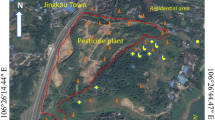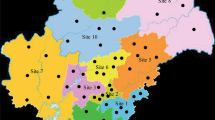Abstract
Plastic waste is a source of organic contaminants such as hexabromocyclododecanes (HBCDs). HBCDs have been found to cause developmental and reproductive toxicity; it is important to investigate the occurrence and metabolization of HBCDs in the soil environments with plastic waste contamination. This work analyzed HBCDs and their metabolites in soil and plant samples collected from Xinle and Dingzhou—the major plastic waste recycling centers in North China. Results showed that total HBCD concentrations in soils followed the order: plastic waste treatment site (11.0–624 ng/g) > roadside (2.96–85.4 ng/g) ≥ farmland (8.69–55.5 ng/g). HBCDs were detected in all the plant samples with total concentrations ranging from 3.47 to 23.4 ng/g. γ-HBCD was the dominant congener in soils, while α-HBCD was preferentially accumulated in plants. Compositions of HBCD isomers in soils and plants were significantly different (P < 0.05) among sampling sites and among plant species. HBCDs in farmland soil and all plant samples exhibited high enantio-selectivity based on the enantiomeric fractions (EFs). Furthermore, metabolites of pentabromocyclododecenes (PBCDEs) were frequently identified in soils, and mono-OH-HBCDs were the most common ones in plants. This study for the first time provides evidences of HBCD contamination in the soil-plant system caused by plastic waste, their stereo-selectivity, and metabolization behavior, improving our understanding of the environmental behavior and fate of HBCDs.




Similar content being viewed by others
References
Abdallah MA, Ibarra C, Neels H, Harrad S, Covaci A (2008) Comparative evaluation of liquid chromatography-mass spectrometry versus gas chromatography-mass spectrometry for the determination of hexabromocyclododecanes and their degradation products in indoor dust. J Chromatogr A 1190:333–341
Alaee M, Arias P, Sjödin A, Bergman Å (2003) An overview of commercially used brominated flame retardants, their applications, their use patterns in different countries/regions and possible modes of release. Environ Int 29:683–689
Avio CG, Gorbi S, Regoli F (2016) Plastics and microplastics in the oceans: from emerging pollutants to emerged threat. Mar Environ Res 1:1–21
Carignan CC, Abdallah MAE, Wu N, Heiger-Bernays W, McClean MD, Harrad S, Webster TF (2012) Predictors of tetrabromobisphenol-A (TBBP-A) and hexabromocyclododecanes (HBCD) in milk from Boston mothers. Environ Sci Technol 46:12146–12153
Cozar A, Echevarria F, Gonzalez-Gordillo JI, Irigoien X, Ubeda B, Hernandez-Leon S, Palma AT, Navarro S, Garcia-de-Lomas J, Ruiz A, Fernandez-de-Puelles ML, Duarte CM (2014) Plastic debris in the open ocean. Proc Natl Acad Sci U S A 111:10239–10244
Davis JW, Gonsior S, Marty G, Ariano J (2005) The transformation of hexabromocyclododecane in aerobic and anaerobic soils and aquatic sediments. Water Res 39:1075–1084
Davis JW, Gonsior SJ, Markham DA, Friederich U, Hunziker RW, Ariano JM (2006) Biodegradation and product identification of [14C]hexabromocyclododecane in wastewater sludge and freshwater aquatic sediment. Environ Sci Technol 40:5395–5400
Desborough JL (2011) Exploring the utility of chiral signatures to further understanding of soil-to-herbage tansfer of persistent organic pollutants (POPs). University of Birmingham, Birmingham
Du MM, Lin LF, Yan CZ, Zhang X (2012) Diastereoisomer- and enantiomer-specific accumulation, depuration, and bioisomerization of hexabromocyclododecanes in zebrafish (Danio rerio). Environ Sci Technol 46:11040–11046
Eguchi A, Isobe T, Ramu K, Tue NM, Sudaryanto A, Devanathan G, Viet PH, Tana RS, Takahashi S, Subramanian A, Tanabe S (2013) Soil contamination by brominated flame retardants in open waste dumping sites in Asian developing countries. Chemosphere 90:2365–2371
Erratico C, Zheng XB, van den Eede N, Tomy G, Covaci A (2016) Stereoselective metabolism of α-, β-, and γ-Hexabromocyclododecanes (HBCDs) by human liver microsomes and CYP3A4. Environ Sci Technol 50:8263–8273
Gao ST, Wang JZ, Yu ZQ, Guo QR, Sheng GY, Fu JM (2011) Hexabromocyclododecanes in surface soils from e-waste recycling areas and industrial areas in south China: concentrations, diastereoisomer- and enantiomer-specific profiles, and inventory. Environ Sci Technol 45:2093–2099
Gregg TT, Kerri P, Tyler O, Thor H, Paul AH, Gordia M, Chris HM (2008) Enantioselective bioaccumulation of hexabromocyclododecane and congener-specific accumulation of brominated diphenyl ethers in an eastern Canadian Arctic marine food web. Environ Sci Technol 42:3634–3639
Guerra P, Eljarrat E, Barceló D (2008) Enantiomeric specific determination of hexabromocyclododecane by liquid chromatography-quadrupole linear ion trap mass spectrometry in sediment samples. J Chromatogr A 1203:81–87
Hakk H, Letcher RJ (2003) Metabolism in the toxicokinetics and fate of brominated flame retardants—a review. Environ Int 29:801–828
Håkas M, Hylland K, Berge JA, Nygåd T, Mariussen E (2009) Spatial diastereomer patterns of hexabromocyclododecane (HBCD) in a Norwegian fjord. Sci Total Environ 407:5907–5913
He MJ, Luo XJ, Yu LH, Liu J, Zhang XL, Chen SJ, Chen D, Mai BX (2010) Tetrabromobisphenol-A and hexabromocyclododecane in birds from an e-waste region in South China: influence of diet on diastereoisomer- and enantiomer-specific distribution and trophodynamics. Environ Sci Technol 44:5748–5754
Heeb NV, Schweizer WB, Mattrel P, Haag R, Gerecke AC, Schmid P, Zennegg M, Vonmont H (2008) Regio- and stereoselective isomerization of hexabromocyclododecanes (HBCDs): kinetics and mechanism of γ- to α- HBCD isomerization. Chemosphere 73:1201–1210
Heeb NV, Graf H, Schweizer WB, Lienemann P (2010) Thermally-induced transformation of hexabromocyclododecanes and isobutoxypenta bromocyclododecanes in flame-proofed polystyrene materials. Chemosphere 80:701–708
Horton AA, Waltona A, Spurgeon DJ, Lahive E, Svendsen C (2017) Microplastics in freshwater and terrestrial environments: evaluating the current understanding to identify the knowledge gaps and future research priorities. Sci Total Environ 586:127–141
Huang HL, Zhang SZ, Lv JT, Wen B, Wang S, Wu T (2016) Experimental and theoretical evidence for diastereomer- and enantiomer-specific accumulation and biotransformation of HBCD in maize roots. Environ Sci Technol 50:12205–12213
KÖpen R, Becker R, Jung C, Nehls I (2008) On the thermally induced isomerisation of hexabromocyclododecane stereoisomers. Chemosphere 71:656–662
Law RJ, Kohler M, Heeb NV, Gerecke AC, Schmid P, Voorspols S, Covaci A, Becher G, Janák K, Thomsen C (2005) Hexabromocyclododecane challenges scientists and regulators. Environ Sci Technol 39:281A–287A
Le TT, Son MH, Nam IH, Yoon H, Kang YG, Chang YS (2017) Transformation of hexabromocyclododecane in contaminated soil in association with microbial diversity. J Hazard Mater 325:82–89
Li YN, Zhou QX, Wang YY, Xie XJ (2011) Fate of tetrabromobisphenol A and hexabromocyclododecane brominated flame retardants in soil and uptake by plants. Chemosphere 82:204–209
Liu WP, Ye J, Jin MQ (2009) Enantioselective phytoeffects of chiral pesticides. J Agric Food Chem 57:2087–2095
Lwanga EH, Gertsen H, Gooren H, Peters P, Salánki T, van der Ploeg M, Besseling E, Koelmans AA, Geissen V (2016) Microplastics in the terrestrial ecosystem: implications for Lumbricus terrestris (Oligochaeta, Lumbricidae). Environ Sci Technol 50:2685–2691
Marvin CH, MacInnis G, Alaee M, Arsenault G, Tomy GT (2007) Factors influencing enantiomeric fractions of hexabromocyclododecane measured using liquid chromatography/tandem mass spectrometry. Rapid Commun Mass Spectrom 21:1925–1930
Meng XZ, Duan YP, Yang C, Pan ZY, Wen ZH, Chen L (2011) Occurrence, sources, and inventory of hexabromocyclododecanes (HBCDs) in soils from Chongming Island, the Yangtze River Delta (YRD). Chemosphere 82:725–731
Ni HG, Lu SY, Mo T, Zeng H (2016) Brominated flame retardant emissions from the open burning of five plastic wastes and implications for environmental exposure in China. Environ Pollut 214:70–76
Palace VP, Pleskach K, Halldorson T, Danell R, Wautier K, Evans B, Alaee M, Marvin C, Tomy GT (2008) Biotransformation enzymes and thyroid axis disruption in juvenile rainbow trout (Oncorhynchus mykiss) exposed to hexabromocyclododecane diastereoisomers. Environ Sci Technol 42:1967–1972
Petersen M, Hamm S, Schäfer A, Esser U (2004) Comparative GC/MS and LC/MS detection of hexabromocyclododecane (HBCD) in soil and water samples. Organohalogen Compd 66:226–231
Rani M, Shim WJ, Han GM, Jang M, Song YK, Hong SH (2014) Hexabromocyclododecane in polystyrene based consumer products: an evidence of unregulated use. Chemosphere 110:111–119
Remberger M, Sternbeck J, Palm A, Kaj L, Strömberg K, Brorström-Lundén E (2004) The environmental occurrence of hexabromocyclododecane in Sweden. Chemosphere 54:9–21
Susanne E, Roland B, Andreas MB, Wolfram B, Christian J, Irene N (2010) HBCD stereoisomer pattern in mirror carps following dietary exposure to pure γ-HBCD enantiomers. J Agric Food Chem 58:9705–9710
Tang ZW, Huang QF, Cheng JL, Yang YF, Yang J, Guo W, Nie ZQ, Zeng N, Jin L (2014) Polybrominated diphenyl ethers in soils, sediments, and human hair in a plastic waste recycling area: a neglected heavily polluted area. Environ Sci Technol 48:1508–1516
Teuten EL, Saquing JM, Knappe DRU, Barlaz MA, Jonsson S, Björn A, Rowland SJ, Thompson RC, Galloway TS, Yamashita R, Ochi D, Watanuki Y, Moore C, Viet PH, Tana TS, Prudente M, Boonyatumanond R, Zakaria MP, Akkhavong K, Ogata Y, Hirai H, Iwasa S, Mizukawa K, Hagino Y, Imamura A, Saha M, Takad H (2009) Transport and release of chemicals from plastics to the environment and to wildlife. Philos Trans R Soc B 364:2027–2045
Thompson RC, Moore CJ, vom Saal FS, Swan SH (2009) Plastics, the environment and human health: current consensus and future trends. Philos Trans R Soc B 36:2153–2166
Velis CA (2014) Global recycling markets—plastic waste: a story for one player—China. Report prepared by FUELogy and formatted by D-waste on behalf of International Solid Waste Association - Globalisation and Waste Management Task Force. ISWA, Vienna, September 2014. Available online https://www.iswa.org/fileadmin/galleries/TaskForces/TFGWMReportGRMPlasticChinaLR.pdf. Accessed 21 June 2016
Wan WN, Zhang SZ, Huang HL, Wu T (2016) Occurrence and distribution of organophosphorus esters in soils and wheat plants in a plastic waste treatment area in China. Environ Pollut 214:349–353
Wong F, Kurt-Karakus P, Bidleman TF (2012) Fate of brominated flame retardants and organochlorine pesticides in urban soil: volatility and degradation. Environ Sci Technol 46:2668–2674
Wu JP, Guan YT, Zhang Y, Luo XJ, Zhi H, Chen SJ, Mai BX (2010) Trophodynamics of hexabromocyclododecanes and several other nonPBDE brominated flame retardants in a freshwater food web. Environ Sci Technol 44:5490–5495
Yu ZQ, Peng P, Sheng GY, Fu JM (2008) Determination of hexabromocyclododecane diastereoisomers in air and soil by liquid chromatography-electrospray tandem mass spectrometry. J Chromatogr A 1190:74–79
Zhai GS, Gutowski SM, Lehmler HJ, Schnoor JL (2014) Enantioselective transport and biotransformation of chiral hydroxylated metabolites of polychlorinated biphenyls in whole poplar plants. Environ Sci Technol 48:12213–12220
Zhang YW, Sun HW, Liu F, Dai YY, Qin XB, Ruan YF, Zhao LJ, Gan ZW (2013) Hexabromocyclododecanes in limnic and marine organisms and terrestrial plants from Tianjin, China: diastereomer and enantiomer-specific profiles, biomagnification, and human exposure. Chemosphere 93:1561–1568
Zhang H, Kuo YY, Gerecke AC, Wang J (2012) Co-release of hexabromocyclododecane (HBCD) and nano- and microparticles from thermal cutting of polystyrene foams. Environ Sci Technol 46:10990–10996
Zheng XB, Erratico C, Abdallah MAE, Negreira N, Luo XJ, Mai BX, Covaci A (2015) In vitro metabolism of BDE-47, BDE-99, and alpha-, beta-, gamma-HBCD isomers by chicken liver microsomes. Environ Res 143:221–228
Zhu HK, Sun HW, Zhang YW, Xu JY, Li B, Zhou QX (2016) Uptake pathway, translocation, and isomerization of hexabromocyclododecane diastereoisomers by wheat in closed chambers. Environ Sci Technol 50:2652–2659
Zhu HK, Zhang K, Sun HW, Wang F, Yao YM (2017) Spatial and temporal distributions of hexabromocyclododecanes in the vicinity of an expanded polystyrene material manufacturing plant in Tianjin, China. Environ Pollut 222:338–347
Acknowledgements
We thank Dr. Rixiang Huang of Georgia Institute of Technology for his English polishing, comments and suggestions on the manuscript. This work was supported by the National Natural Science Foundation of China (Projects 21577155, 21537005, and 21621064) and the Strategic Priority Research Program of the Chinese Academy of Sciences (XDB14020202).
Author information
Authors and Affiliations
Corresponding author
Additional information
Responsible editor: Hongwen Sun
Electronic supplementary material
ESM 1
(DOCX 179 kb).
Rights and permissions
About this article
Cite this article
Huang, H., Wang, D., Wan, W. et al. Hexabromocyclododecanes in soils and plants from a plastic waste treatment area in North China: occurrence, diastereomer- and enantiomer-specific profiles, and metabolization. Environ Sci Pollut Res 24, 21625–21635 (2017). https://doi.org/10.1007/s11356-017-9792-9
Received:
Accepted:
Published:
Issue Date:
DOI: https://doi.org/10.1007/s11356-017-9792-9




